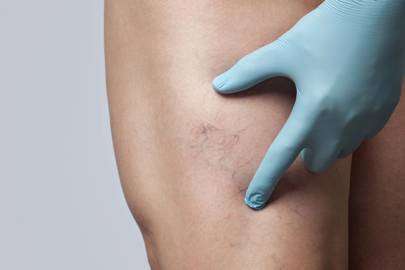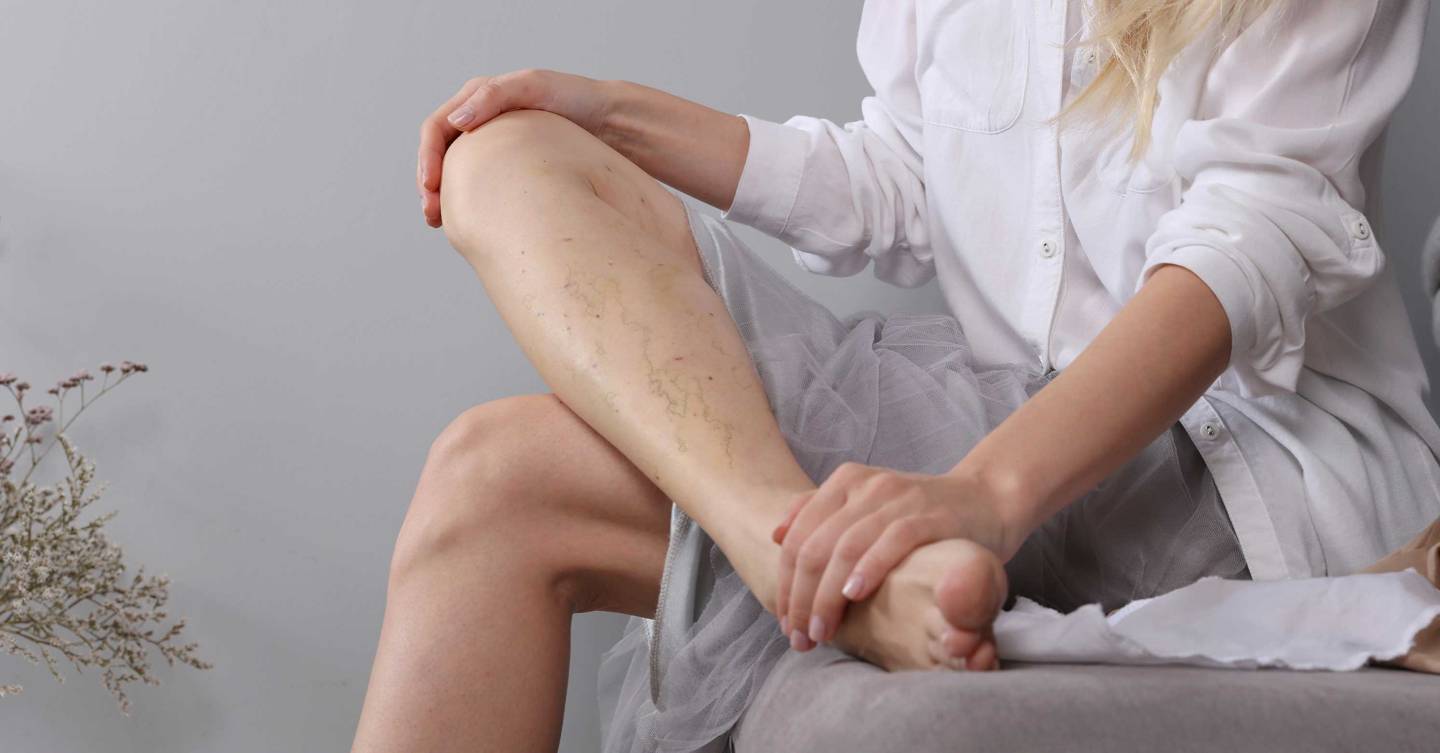Ever noticed those thin, squiggly red lines on your skin? Chances are you have – along with an estimated 60% of the population. They’re called spider veins (otherwise know as thread veins, or their technical name, telangiectasia varicose veins) and, luckily, are almost always harmless.
We are all about embracing every incredible part of our body here at GLAMOUR but if you feel uncomfortable with your spider veins, especially if they crop up on an obvious part of their body or face, there are ways to manage them. Plus, they can arise as a sign of another health condition, so it’s always good to get to grips with what’s going on beneath the surface.
To answer every question you may have about spider veins, we’ve called upon the experts to share everything you need to know from what they are, to why they happen, to how to get rid of them if you so wish.

Getty Images
What are spider veins?
Otherwise known as thread veins, spider veins are thin, small blood vessels that are visible through the skin. Not to be confused with varicose veins, spider veins do not bulge underneath the surface.
“They are a collection of small, dilated arterioles (blood vessels) clustered very close to the surface of the skin,” explains Dr Rekha Tailor, cosmetic doctor at Health & Aesthetics. “The cluster of vessels is web-like with a central spot and radiating vessels, which is where they get their name.”
“These veins form when typical blood circulation processes are interrupted,” says Dr Ioannis Liakas, medical director at Vie Aesthetics.
“We have valves in our veins allow blood to flow through in a one-way system. When veins become weak, some blood can leak back through, it can get stuck and cause a build-up of pressure which causes the vein to grow. This results in the appearance of larger varicose veins or smaller and closer to the skin’s surface (spider veins).”
What causes spider veins?
The exact cause of spider veins isn’t entirely understood, but as with most things, there seems to be a genetic connection. Other factors that have been associated with spider veins are being overweight, having a job that requires prolonged periods of standing and being female (they are often first noticed during pregnancy).
“It can be the luck of the draw whether or not you develop spider veins as they can be hereditary or appear during pregnancy,” says Amar Suchde, AMS Aesthetics. “They can also occur in both men and women through weight gain, regularly standing for long periods of time or physical trauma to the area.”
Are they dangerous?
While they may make some feel self conscious, the good thing about spider veins is that they are not harmful to physical health. “They are generally very harmless and pose no medical concern,” assures Dr John Quinn, cosmetic doctor at Quinn Clinics. However, spider veins can occasionally arise as a result of another medical condition like rosacea that may benefit from treatment. “Spider veins could be a sign of another condition, most often rosacea,” explains Nalan Aksahin, Senior Aesthetician at Rejuv Lab London. “If you’re concerned, please visit your GP or a dermatologist for a diagnosis.”
Where can you get spider veins?
You can get spider veins anywhere on your face or body, but they are particularly common in certain places. “They’re usually found on the legs, face, hands and upper body, and they appear as a network of thin, red, purple or blue lines in a localised region,” explains Amar.
How can I treat them?
While not usually a cause for medical concern, many people want to get rid of visible veins for cosmetic reasons. “The primary way that spider veins are treated is by closing off the vein so that it collapses and the blood flow stops completely,” explains Dr Tailor. “Spider veins are all superficial veins, so other healthy veins just take over their circulation duties and the procedure won’t impact your overall health.”
The most popular treatment is sclerotherapy, which involves a series of small injections. “This is virtually painless and the chemical used in the injection causes the vein to become sticky and close off,” he says. “There may be bruising at first but this will quickly fade.”
IPL Laser is another effective and popular treatment option, which involves pulses of intense light, which are aimed at the vein and break it down. “It’s quite simple to treat the condition in clinic with some IPL sessions that absorb and collapse the capillaries with no damage to the surrounding tissue,” assures Nalan.
Other treatments include endothermal ablation, (where heat is used to seal the affected veins, sclerotherapy (which uses a type of medical foam to close the veins) or ligation and stripping (when the affected veins are surgically removed).
How do you prevent spider veins?
While it’s hard to prevent something when the exact cause isn’t understood, there are certain things that can be done to reduce the likeliness of getting spider veins. “There are a number of lifestyle factors that can increase your risk of getting vein problems and should be avoided if possible,” says Dr Tailor. “These include obesity, lack of exercise, poor circulation, a diet that’s low in fibre and high in salt, and prolonged periods of standing.”
[article url=”G0zdzlngPoy”]
